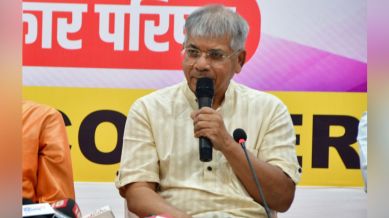Stay updated with the latest - Click here to follow us on Instagram
‘How can Marathas avail multiple quotas?’: Prakash Ambedkar lashes out at Fadnavis Government over assurance to Manoj Jarange Patil
Vanchit Bahujan Aghadi leader Prakash Ambedkar also said that the Marathas have always been a socially forward class, and there are no instances to show they were socially boycotted or victims of untouchability.

Days after the Maharashtra Government issued a GR implementing the Hyderabad Gazette to extend Kunbi status to the Marathas of the state’s Marathwada region, Vanchit Bahujan Aghadi president Prakash Ambedkar Friday raised questions over its impact on the OBC community.
Ambedkar also said that the new Government Resolution will be subject to legal challenges, and pointed at the unhappiness of the Other Backward Class community. “There is no ambiguity that the new GR will also be subjected to legal challenges. The OBCs are very upset as they perceive the decision as a backdoor entry of Marathas in the OBC quota,” he said.
monthly limit of free stories.
with an Express account.
“How can one community avail multiple quotes in Maharashtra? Today, Marathas are getting a 10 per cent separate quota in education and employment under the Socially and Economically Backward Class Act (SEBC). Under the Economically Weaker Sections (EWS), the Marathas get reservations. And, now they have extended the Kunbi status to avail OBC reservation.”
The VBA chief also said that the Marathas have always been a socially forward class, and there are no instances to show they were socially boycotted or victims of untouchability.
“What is acceptable is the fact that there has been a sharp divide between the rich and poor Marathas over the decades. The socially and economically prosperous Maratha families, who have dominated the politics of Maharashtra and prospered by establishing a network of educational and sugar factories, have failed to accommodate the poor Marathas. The agrarian distress, with the majority of farmers representing Marathas, is a reality. But then we have to direct these questions at those upperclass ruling Marathas,” he asserted.
Karpoori Thakur formula
Maharashtra Chief Minister Devendra Fadnavis has made it clear that not all Marathas will get the Kunbi status, but only those whose credentials based on valid documents and proofs are ascertained will be entitled to the certificate.
According to Ambedkar, if those getting the Kunbi status are covered under OBC, there will still be a sizeable section within the Marathas who will not qualify for the certificate. He pointed out that they will get covered under the 10 per cent quota.
Unlike the Maratha reservation protest, OBCs with 350 communities are a disintegrated group. Therefore, OBC leaders are speaking individually, representing their respective constituencies or regions, and there is no unanimity on the next course of action.
On Thursday, Babanrao Taywade-led National OBC Federation, which launched a chain agitation last month to oppose the inclusion of Marathas within the Other Backward Class category, called off the agitation following an assurance from the government that their quota will not be diluted.
“In the Vidarbha region, the Kunbi community is listed in the OBC category. There is a provision for allowing Kunbis to avail the OBC quota. In that sense, the state government has reiterated its stated position on the issue. The OBC quota is not going to be adversely affected. Our quota will remain intact,” Taywade said.
Another OBC leader, Haribhau Rathod, suggested that the government should take a look at the formula devised by the former Bihar chief minister Karpoori Thakur. “In 1978, Karpoori Thakur introduced a 26 per cent reservation model in Bihar for the Backward Classes in government jobs and education. The break-up was OBC 12 per cent, Most Backward Class 8 per cent, women 3 per cent, and Economically Backward Class (for upper caste) 3 per cent.”
“Former Maharashtra CM Vasantrao Naik also introduced reservation for the denotified and Nomadic Tribes. The reservation within the OBC category based on sub-categorisation is the only solution to resolve the Maratha versus OBC conflict in Maharashtra. Why is nobody in the government looking at a solution which is before them? It will end all problems,” added Rathod.
“Raise the OBC quota from 27 to 38 per cent. Broadly, OBCs should be divided into three groups. First group should include the denotified tribe, 4 per cent; the nomadic tribes, 3 per cent; Dhangar, 4 per cent; Vanjari, 3 per cent. In group two, special Backward Class 2 per cent; Barabalutedar 3 per cent; Teli, Mali, Agri, Bhandari 4 per cent; Kachi, Kushwaha, Shaky, Saini, and others 5 per cent. In the group three category, Kunbi, Kunbi-Maratha, Maratha-Kunbi, Maratha-Leva, Patidar and Rajput, 10 per cent should be there. The total reservation under OBC, including all three groups, will not exceed 38 per cent.”
While this model will accommodate all Marathas, it will also ensure that the existing OBC quota of 27 per cent will not be diluted, he asserted.